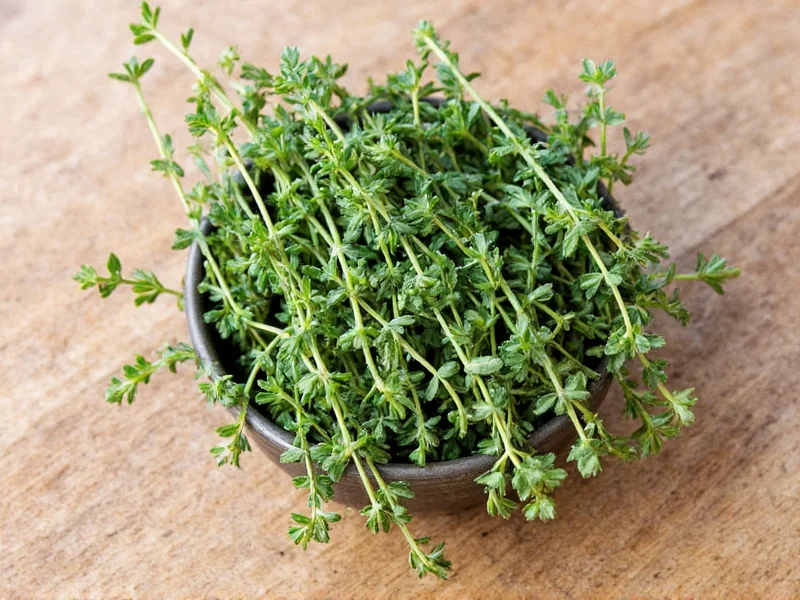When adapting recipes that call for thyme, knowing the exact fresh-to-dry conversion ratio is essential for balanced flavor development. Fresh thyme contains approximately 85% water content, which evaporates during the drying process, concentrating the herb's aromatic compounds and resulting in more potent dried thyme. This concentration explains why you need less dried thyme than fresh to achieve equivalent flavor intensity.
Understanding Thyme's Flavor Transformation
The drying process fundamentally alters thyme's chemical composition. As moisture evaporates, volatile oils like thymol and carvacrol become more concentrated, creating a more intense but slightly different flavor profile. Fresh thyme offers brighter, grassier notes with subtle citrus undertones, while dried thyme develops earthier, more medicinal characteristics with deeper woody notes. This flavor evolution means that while the 3:1 ratio provides proper seasoning strength, the final dish's flavor profile will differ slightly depending on which form you use.
Precision Substitution Guidelines
For accurate recipe adaptation, follow these specific substitution guidelines based on measurement type:
| Measurement Type | Fresh Thyme | Dried Thyme | Best For |
|---|---|---|---|
| Volume (teaspoons) | 3 tsp | 1 tsp | Sauces, stews, braises |
| Volume (tablespoons) | 1 tbsp | 1 tsp | Roasts, marinades |
| Stems | 1 sprig (4-5 inches) | ¼ tsp | Bouquet garni, slow cooking |
| Weight | 3 grams | 1 gram | Professional recipes, baking |
When to Adjust Beyond Standard Ratios
While the 3:1 ratio serves as an excellent starting point, several factors may require adjustments to achieve optimal results:
- Recipe cooking time: For dishes simmering longer than 2 hours, reduce dried thyme by 25% as prolonged heat intensifies its flavor
- Thyme variety: Lemon thyme requires a 2.5:1 ratio due to its more delicate flavor profile
- Dried herb age: Thyme older than 6 months loses potency; increase quantity by 15-20% for older dried thyme
- Dish acidity: In highly acidic preparations like tomato sauces, increase dried thyme by 10% as acid diminishes herb perception
Maximizing Flavor in Your Cooking
Understanding when to use each form of thyme significantly impacts your culinary results. Fresh thyme excels in dishes with shorter cooking times where its bright, complex notes can shine—think finishing sauces, salad dressings, or vegetable sautés. Add fresh thyme during the last 10-15 minutes of cooking to preserve its delicate flavor compounds.
Dried thyme works best in long-simmered dishes where its robust flavor can gradually infuse throughout the cooking process. For optimal results with dried thyme, bloom it by toasting in oil for 30-60 seconds before adding other ingredients. This technique releases trapped essential oils, creating a more rounded flavor profile that better approximates fresh thyme's complexity.
Storage Techniques for Maximum Freshness
Proper storage dramatically affects both forms' shelf life and flavor retention. For fresh thyme, treat it like cut flowers: trim stems, place in a glass with 1 inch of water, cover loosely with a plastic bag, and refrigerate. This method maintains freshness for 10-14 days. Alternatively, freeze fresh thyme sprigs in olive oil using ice cube trays for ready-to-use portions in cooking.
Dried thyme maintains peak flavor for 6-12 months when stored properly. Use airtight glass containers away from light, heat, and moisture. Avoid storing near stovetops or in clear plastic containers that degrade essential oils through light exposure. To test dried thyme's viability, rub a small amount between your fingers—if the aroma is weak or musty, it's time to replace your supply.
Common Substitution Mistakes to Avoid
Cooks frequently make these errors when converting between fresh and dried thyme:
- Using equal volumes (1:1 ratio) which creates overpowering, medicinal flavors
- Adding dried thyme at the same stage as fresh, resulting in harsh, bitter notes
- Not accounting for dried thyme's delayed flavor release in quick-cooking dishes
- Using dried thyme in raw applications like salads where fresh provides superior texture
For raw preparations like compound butters or salad dressings, fresh thyme is always preferable. Its tender leaves integrate smoothly while dried thyme's brittle texture creates unpleasant mouthfeel in uncooked applications. When substituting in baking applications, reduce dried thyme quantities by an additional 25% as oven heat further concentrates flavors.
Professional Chef Insights
Experienced chefs employ several advanced techniques when working with thyme:
- Layering forms: Combine 75% dried thyme early in cooking with 25% fresh added at the end for complex flavor development
- Infused oils: Create thyme oil using equal parts fresh and dried thyme for balanced flavor extraction
- Temperature control: Add dried thyme when liquids reach 160°F (71°C) for optimal flavor release without bitterness
- Acid balancing: When using dried thyme in tomato-based dishes, add ¼ tsp lemon zest per teaspoon of dried thyme to brighten flavors
Scientific Basis for the Conversion Ratio
Research published in the Journal of Food Science confirms the 3:1 ratio through moisture content analysis. Fresh thyme contains 82-87% water by weight, while properly dried thyme measures 6-9% moisture content. This significant water reduction concentrates flavor compounds approximately threefold. The study also found that thymol concentration increases from 0.8% in fresh thyme to 2.3% in dried thyme, explaining the potency difference.
Interestingly, the research revealed that oven-dried thyme maintains slightly higher essential oil concentrations than air-dried thyme, suggesting home-dried thyme may require minor ratio adjustments compared to commercially dried products. For home-dried thyme, a 2.7:1 ratio often produces better results than the standard 3:1 conversion.
Practical Application in Popular Recipes
Understanding these principles transforms common recipes:
- Coq au Vin: Use 3 sprigs fresh thyme (or 1½ tsp dried) added with the wine for proper infusion without overpowering
- Roasted Chicken: Rub 1 tsp dried thyme under skin (equivalent to 3 tsp fresh) for even flavor distribution
- Tomato Basil Soup: Substitute 1 tsp dried thyme for 1 tbsp fresh, but add during last 5 minutes of cooking to prevent bitterness
- Lemon Thyme Shortbread: Reduce dried thyme to ¾ tsp when substituting for 1 tbsp fresh due to lemon thyme's delicate profile











 浙公网安备
33010002000092号
浙公网安备
33010002000092号 浙B2-20120091-4
浙B2-20120091-4